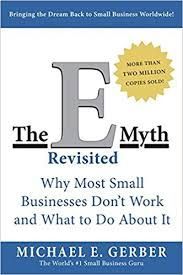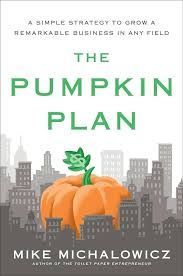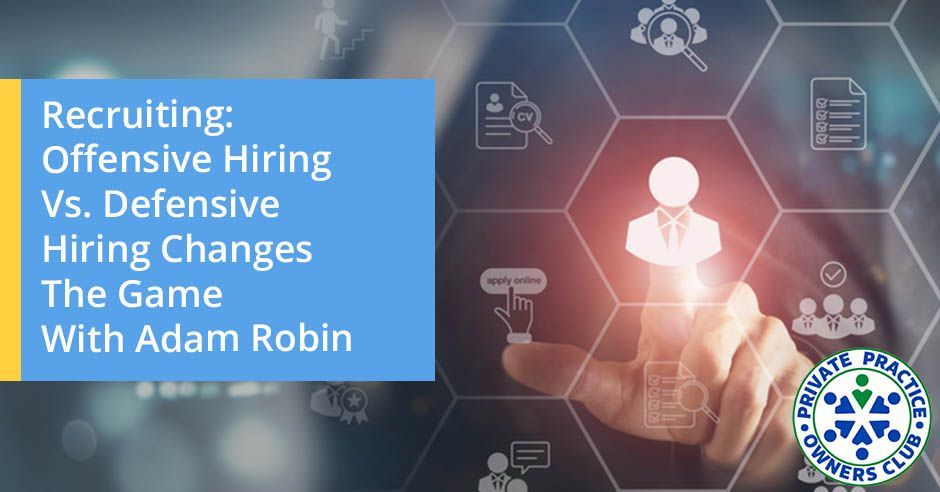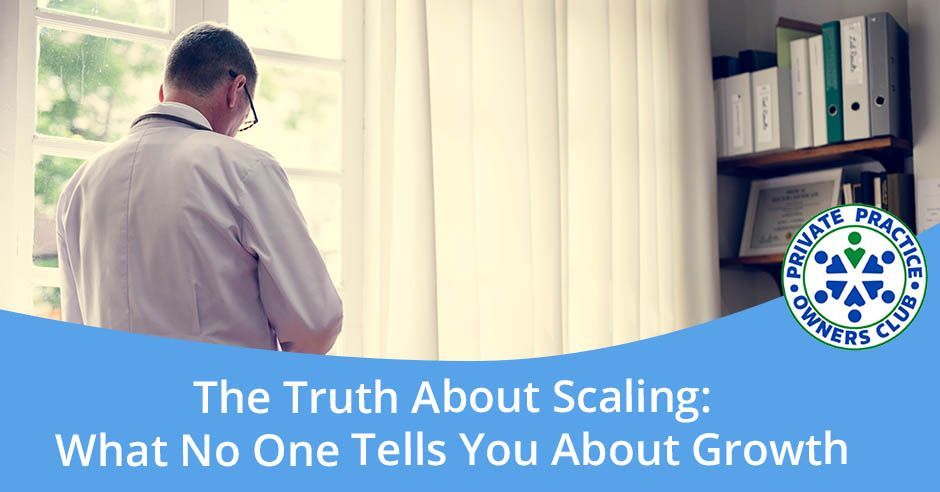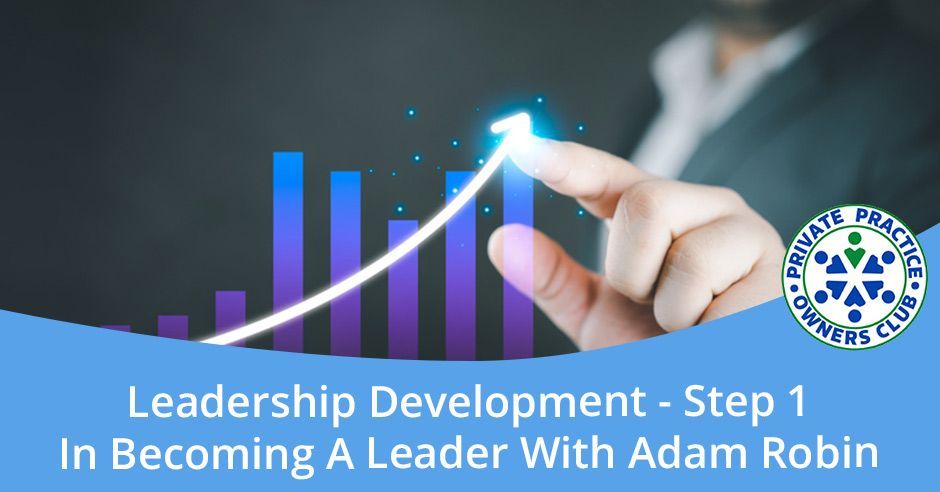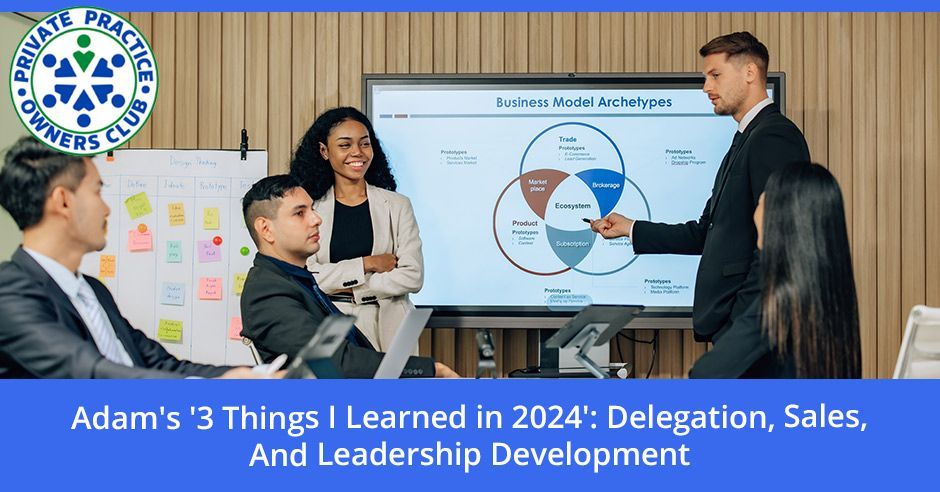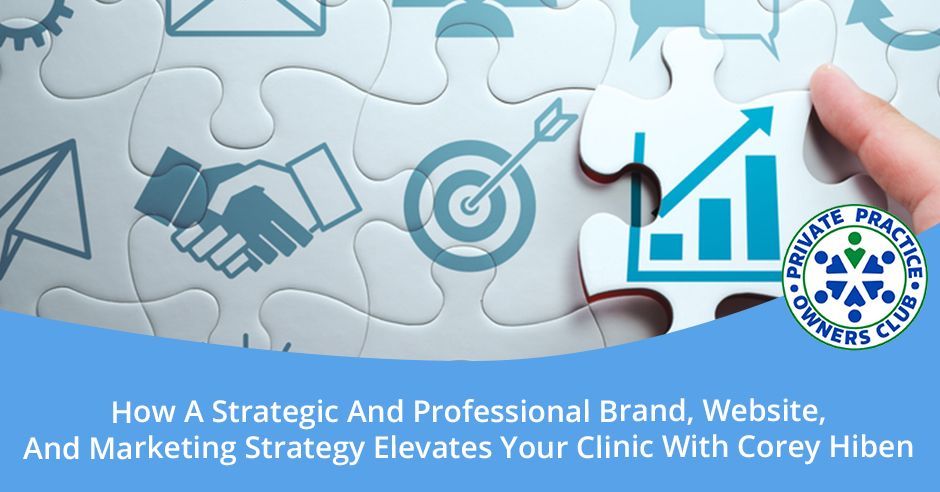In this episode of the Practice Owners Manual series, Nathan and Adam thoroughly explore the fundamentals of Practice Management. This insightful two-part series kicks off with the crucial task of organizing your clinic's foundational documents and policies, covering everything from establishing an organizational board to formulating job descriptions.
Throughout the episode, Nathan and Adam delve into the significance of having a well-structured organizational board, the process of creating and implementing effective policies and procedures, and the art of crafting clear and concise job descriptions that drive productivity.
Countless clinic owners find themselves at a standstill due to a lack of organization. Drawing from their own experiences, Nathan and Adam provide practical tips to help you sidestep common pitfalls. Gain valuable insights into effective delegation, team management, and the implementation of systems that will fuel the success of your clinic.
Don't allow disorganization to hinder your progress. Watch this episode to gain the valuable insights and tools needed to elevate your clinic.
Want to talk about how we can help you with your Private Practice business, or have a question you want to ask? Book a call with Adam -
https://calendly.com/adamrobin/dr-adam-s-30-minute-connection
---
Listen to the podcast here
Practice Owners Manual Series, Part 7 (1st Of 2) - Practice Management And General Structure
Welcome back to the next episode in our series of the Quintessential Bulletproof Practice Owner’s Manual for Success. Hopefully, you appreciated the previous episode, took lots of notes, and did some homework. Now get ready to do some more work on your business. Get out pad and paper and let’s go.
---
Welcome back to the show and our next episode in the Practice Owner’s Manual series. If you’ve been tuning in this far chronologically week after week, this is number seven in our series of episodes. Last time, we talked about the PCC or Patient Care Coordinator and the person at the front desk. This episode is in concurrence with the next episode. This is going to be a two-part series where we’re going to talk about practice in management.
We’re going to talk a little bit more about the fundamental practice organization, like the manuals that you want to create. Next time, we’ll talk about the management of the employees, the team, and human resources-related issues. This one is going to be a little bit more about how to structure, organize, and put some of our documents and important things together to make sure we’re nicely organized and structured.
Adam, thanks for coming back again. I appreciate it.
Let’s rock and roll.
Practice Management
As you’ve said before in previous episodes, this is the time to get out pen and paper. Next page on the notebook. This is practice management. We’re going to be talking about stuff like organizational board, policy and procedures, and job descriptions. Some of that stuff can be a little bit hairy because a lot of people are like, “I don’t know where to start.” I didn’t know where to start when I had my practice but we’re going to get into some of that stuff, which can be some of the grind.
Nobody has time to do this stuff. The hard part about this is this is where most people get stuck. This is the ball of practice owners in our country. It’s people who are too busy and not organized enough. They’re not tightened up on who does what, when, where, why, and what the roles and responsibilities are for people on their team, checklists, and sequences of how to get things done. It takes some brain work to step out of the business, put this down on paper, and deliver it in a way that’s valuable for your team. This is important.
One of the reasons why the book
E-Myth Revisited is so popular is because it speaks exactly to the point that we’re talking about. It is the small business owner’s problem conundrum. They end up spinning their wheels covering all the different aspects of their company, then get burned out because they have taken the time to do the things that we’re talking about.
It’s common because of that entrepreneurial mindset. We get the shiny objects syndrome and the next bright idea like, “I need to work on this next bright idea. That’s where all the money is going to be. I don’t have time to work on the important stuff. That’s my bread and butter.” This is exactly where that starts. This is how you create the foundation of your company.
It hurts me a little bit because so many owners want to grow and expand and get a new practice before this point. This point is completely essential before you open up that next clinic. It’s super helpful before you hire that next provider. Not necessary, but super helpful. Any time you want to expand and grow, this is fundamental in that process. Otherwise, you’re going to have a lot of chiefs and not enough Indians. They’re going to create their own culture. That’s not by intention. That’s not what you create. It’s what the group decides to create in spite of you. This becomes a pain point for many owners in creating this foundation.
I talked to owners all the time. Many of you guys, I’ve talked to you on the phone or Zoom. I’d say 80% to 90% of you all want the same thing. You want freedom, time with your family, be present, and have dinner with your family at night. You don’t want to be a slave to your business. Unfortunately, this is the only way to achieve that. You have to develop structure and systems.
When I started coaching you a number of years ago, you didn’t have any of this stuff together. You had a clinic with a partner. He didn’t have any of that stuff together. As I started coaching you, I expressed the importance of this, or at least, I relayed the importance of it at the time. How did you eventually start getting some of this stuff done? Did you have to set aside or block time? Did you have to force yourself? Did you have reminders? How did you do it?
I didn’t go full tilt into this until I had about maybe two and a half providers on my team. I was able to breathe a little bit. I would block off a chunk of four hours a week. I would sit in front of my computer. I started printing off all the things I had ever written down and tried to get to what I had to put my hands on it. I put it in chronological order that made sense to me, then I started brain-dumping. It’s like playing with Play-Doh. In the beginning, it’s this ball of nothing but then over time, it starts to take form and shape. Once it starts taking shape, it turns into a tool that you can use.
It takes a little bit of trust and willingness to jump in and start using your creative energy. The biggest challenge that I had as I reflected during that time is I was so used to being able to envision the result I wanted, and then just do it. I would do it. It would be like, “Idea, do.” What I didn’t realize is there was a decision-making process algorithm that was happening inside my brain that I didn’t realize I was doing but I was just doing it.
It took me some quiet time to be like, “Why do I do that?” First, I turned the computer on, then I clicked the button. Once I see this, then I do that. Once I do that, then I do this. I had to slow things down and dissect my decision-making process throughout the company, how I do intake, hiring, and all those things. It’s a skill and once you get used to using that part of your brain, you can access it a little quicker. You just have to practice it.
We mentioned this in the last episode and I’m sure you’re willing to share. I’ll say it again in this episode. Some of the procrastination or the hesitancy in moving forward on creating policy and procedures or boards and job descriptions. In my past, it had to do with, “I don’t even know where to start. What does that look like?”
Using the template that you’ve recommended and shared, reach out to
Adam@PTOClub.com. We’re more than willing to share what a job description looks like and what are some of the important elements. If I had that template and maybe some idea of what some of the verbiage should be and how it’s organized, I could throw in my own language now and get rolling. My obstacle is I can’t envision what that looks like.
If I have a template, that’s done, and then I can replicate that and it works. It becomes a little bit easier for me to now create policies and procedures. I knew that we wanted to do conferences going forward. We have this first one coming up in September 2024 in Clearwater. You can go to
PPOClubEvents.com. Make sure you register. We plan on having annual conferences and I don’t want to recreate this wheel every time.
I sat down and I was like, “I have an idea of what some of the moving parts are and a semi-idea of what the time frames are. Now, I can go back and start building this process out so that come this time next year, I can go back to this policy and follow it.” The whole idea is to get to that point where you can create policies and procedures for your team.
Creating Policy
Once you do it, ideally you have some other people around you. This is my next question for you. If you have some other people around you who are skilled, professional, trustworthy, and highly productive, they can start creating some of these policies for you as well. Have you been able to get to that point where some of the leaders in your team are creating policy?
Yeah, of course. Part of the journey that you go through or go down as an owner is you’re figuring it out. You don’t have all the answers, especially in the beginning. Your job is to put your gloves on, start swinging, and figure it out. In the beginning, there’s so much that you don’t know that there’s massive amounts of overwhelm. Once you start to elevate your skillset, you have more perspective on what you’re doing with your role.
Part of the journey that you go through or go down as an owner is figuring things out. You don’t have all the answers, especially in the beginning.
As you’re tackling new things or as you’re doing it, you’re already thinking about, “How do I train somebody else to do this?” As opposed to doing it for ten years and then figuring out how to train somebody. You’re doing it the first time you’re doing it. That way, it’s only going to land on your plate for maybe a quarter, then it’s already gone. You’re already delegating it. Once you get good at it, then you can train other people like, “This is the SOP on how we create SOPs.”
What is SOP?
Standard Operating Procedure. Here’s the policy and procedure and the template of how we create training, checklists, and to-do lists.
They should have been exposed to this already. It isn’t foreign to them. You said you started writing down your thought processes. We’re willing to share with you a template of what that patient care coordinator job description looks like. Did you get any inspiration from other books in the creation of these things as well? I know
Traction has some good stuff in regard to the organization board.
I referenced that enough somewhere around pages 90 to 100 or something like that. We hired somebody to do our employee handbook. It’s this pamphlet of pages that explains all the HR policies and it was well spent $2,000 to get this professional to do it for us and make it specific to our state laws. It was a beautiful thing. Was there anything else where you got some help in how to organize and put this stuff together?
Traction is probably the best place to start. Aside from that, just coaching. I’ve worked with probably 10 or 15 coaches at this point. Coaching is probably the biggest thing but Traction is a good place. There are tons of stuff on YouTube and information. You can get stuff anywhere on how to put together policy procedures and organizational boards.
I liked Mike Michalowicz’s Pumpkin Plan. In my most recent clinic, I worked withBCMS. They were a compliance company. BCMS provided all the regulatory stuff, the things that we had to have at the federal and state levels according to our state guidelines. It was nice that they provided all of that. I didn’t have to put together a regulation part of it in terms of the documentation that had to be had, “This is the private practice or the Practice Act for our state. We follow these guidelines.”
They had that all together and it was even online. I didn’t have to print it out but it was available. They updated it. There are resources like that as well that I’d recommend people to have, but it doesn’t come back to how we do things in our clinic. This is how we answer the phone. This is what the job means for a patient care coordinator. These are their KPIs. This is how we’re going to review you. That’s all stuff that we still had to come up with on our own.
Organizational Board
Let’s start at a higher level on the organizing board. There are different ways I’ve heard of it, organizing board, organizational board, or organization board. Whatever it is, there are different ways to do it, but it’s your typical tree pattern of the organization with your board of directors at the top, followed by the CEO, president, and then the different divisions. Typically, those divisions are across the board. This was our version. It could be varied a little bit. It might even be different a little bit from Traction, but we had HR-related stuff, finance, operations, and sales. Did yours vary much from that?
We also have an administration as well. It’s recruiting, marketing, operations, administration, and finance. There are five components. That’s how I do it. That’s what works for me.
That works for the way your brain works. When you say operations, that is typically the biggest part. Operations is where all the physical therapy happens. Operations usually include quality assurance as well, so it’s the major portion. That is the thing that keeps the business humming. The other things are helpful, but that’s how we laid it out as well.
When you when you start with this organizing board, it’s important to have the titles in place. Initially, as a young owner, you’re going to have your name in all of those. You’re going to have the title of each. You’re going to have a board of directors, CEO, director of recruiting, director of marketing, and director of operations. You name it. We call them VPS of the different divisions. Mine and Will’s names showed up 5 or 6 times across that organizing before the board before we started moving people up into those seats.
It's good to have the visual because you can show this to your team and say, “This is what our organization looks like. This is where you are.” If it’s a provider, they’re going to be somewhere down the line. There are directors of operations and probably clinic directors that report up to that director or VP, whatever you call them. There are going to be providers underneath that clinic director, technicians, and PTAs in line going vertically in that division.
You can take a PT or a technician and say, “This is where you are on the organization board.” Not only do these show lines of authority but they also show lines of communication. It’s important to show that visual for people when you’re talking about the org board and make it part of the onboarding process.
We had it in our clinics. We had the organizing board posted in the break room of each of our clinics. They knew what the organization looked like, who to talk to, where the authority lines go, and who’s over what so they had a good idea of who’s over what, what their responsibilities are, and where I fit in the organization. It seemed like people liked having that visual. Somehow it provided some mental clarity.
The two places that I have seen this be helpful for us in our company, as you mentioned, is in communication. Communication becomes a lot more challenging as you get more people. Who goes to who for what? That doesn’t mean that I can’t talk to other people along the board but some conversations are reserved for a specific person in the company. If they get out to too many people, then that’s when the confusion starts to develop and that’s not good. We’ve all had to learn those lessons and challenges of communication. Communication is huge. I would be willing to bet that’s probably one of the biggest reasons why people get burned out. It’s because they have a lack of control over the communication in their company.
One of the biggest reasons why people get burned out is having lack of control over the communication and their company.
The second thing is accountability. It doesn’t necessarily directly highlight accountability all the time, but who owns it? This can be a very good starting point to help you get clear on who should own this part of the company or this part of the process because if everybody owns it, then nobody owns it. That’s where I found the most help with our board, communication and accountability.
As we build out our organization board and spend more time on it. In those boxes, we had a title and the name for that title. That would change over time as people left the organization or moved up to take those seats. In that same box, what was their main product? If it’s a provider, your product is to have happy patients who are referring their friends and family to you, getting great results.
Their KPIs, how do we measure that product? It's the number of patients seen. For them, it’s also numbered skilled units built per visit. We had a number of KPIs specifically for that provider box. That’s exactly what you’re talking about. How do they know they’re performing in that role in the company? What are we holding them accountable to on a quick easy visual?
Have you ever used Google Maps?
Yes.
You zoom all the way out and you see the globe. You’re like in space. That’s the old board. That’s why my whole head is wrapped around the whole company at that point. If you want to zoom in a little bit closer, let’s say you want to go down to the country level, where there are some dividing lines between parts. Now you’re talking about specific job descriptions inside of each of these departments, PTs, front desk, marketing people, and digital marketing people. That’s when you start getting into the job description, zooming in more detail.
On an org board, these are high-level items that we’re putting in there. We’re not putting a lot of description into these boxes. These are just the most important parts regarding that position. It becomes exciting for people. I had an experience where I had a PTA. At one point, we had a coach who was coaching Will and me as the owners.
Also, we made her available to some of our leadership team to coach them separately from us. That was hugely valuable. She took one of our PTAs who was doing some marketing but also working as a PTA in the provider space. She brought her over to the org board and it was big. We had a 6 by 4 foot org board. She said, “We want to go on the company,” and started tearing up. She’s like, “Are you serious? I could move somewhere higher up?” She’s like, “Yes. It is up to you. Where would you want to go?” She’s like, “I want to go there.” It was the VP of marketing.
For her to have that visual space to dream and have the visual perspective was huge. Now she knew what she was driving for. When we told her, “That’s a total possibility.” She’s like, “Shut up. I never would have thought in a million years you guys would let me do that.” We’re like, “Yes.” That was a great experience that I had with the org board. It was helpful for us and it’s helpful for the young owners to visualize where they at and what they’re doing.
We’ve talked about leadership development. Where are they going? What are you moving them up to? Not to discount the communication lines that are put in their space. If you’re a provider, you don’t go over and talk to the marketing person and tell them what to do. Your lines of authority go up to the clinic director. If you have some ideas, you talk to the clinic director and maybe the clinic director will go talk to the director of marketing, “Here are my ideas.”
The thing that comes to mind for me is what a great gift that you could give somebody. You put in all that work and build that awesome opportunity for people. That’s when it gets fun.
Job Descriptions
We talked a little bit about job descriptions in the last episode. We might not have to get into it too much. You’re willing to offer a template for it, but tell me a little bit about how you build out your job description. What made it easier for you? What was a challenge that you had regarding building those out?
Same. I’m looking at a blank piece of paper, “Where do I start?” You can google some basic job descriptions and start getting some perspective on how you could start. By the way, you can do it any way that you want. I’m not a job description expert. I would have to pull out a job description to give you the exact details of everything that’s on ours.
In general, you would want to start with the purpose of the position, what’s the purpose, what’s the product, what are the key responsibilities, and how we measure success in the role, then maybe some basic requirements. You must pass. You have a license and graduate from the leadership program and whatever it is. You have your purpose, product, key roles, responsibilities, stats on how you measure performance, and some requirements to be approved. That’s a great place to start.
I’m a little bit older. I would assume that AI could do a lot of this for you now because even when you were doing it years ago, I don’t think AI can.
It wasn’t a thing.
It wasn’t ubiquitous like it is now, but now that there is AI, you can put in the proper prompt and say, “I’m a physical therapy clinic owner. I need a job description for a front desk person with a purpose, product, KPIs, and requirements for the position.” That will probably get you 60% to 70% of the way there. You can probably do that with any other position on the org board, then you can take that and start individualizing, customizing, and making it your own. Ask for 2 or 3 different versions then compare that with what Adam shares with you.
Creating a job description does not have to be that hard. One of the issues that I also came up against and we had to remind our leadership team was it’s okay if it’s not perfect right now. We’re going to roll this out and they’re going to be problems with it. We’re going to find out and take those opportunities to change it and modify it. When we bring it out to our team, we’re like, “This is version 1.0. We expect there to be problems and not to answer all the questions.”
There should be 10,00 more versions at the same time.
“This is a living breathing document but this is what we’re going to start with, how we’re going to train, and hold you accountable until we find modifications that we have to make.” As long as we were clear with that, it doesn’t have to be perfect. Let’s just get started on something and implement it right away.
As I heard you talk, I had a great framework or mindset around why this is important that I wanted to share. It took me a while to recognize or realize you’re not writing this stuff down on paper just so you can say, “I’m cool. I’ve got something written down on paper.” This is a tool that you use. I don’t know if you guys ever see the ads forTrainual. I never use Trainual. I know some people who do. Supposedly, it’s a great product but one of their ads is like, “Having your policies and procedures is having the smartest employee you could ever imagine that will never quit.”
There’s nothing they don’t know about your company. What this does is you remove yourself as the person who tells everybody what to do. You get it to this person called your policies and procedures or your job descriptions. Now that is the decision-making process in the company. You have to be willing to be like, “I’m going to be okay with what I have written down being the decision-maker.” If you making wrong decisions, it’s not, “Let me try harder next time.” It’s, “Let’s fix the policy or the document.” Whenever you can let go of that decision-making authority and give it to your system, then you can let it manage your employees or your team.
The creator of Trainual was inthe Entrepreneurs Organization, EO. It’s a national organization of small business owners. He was in there and worked with one of our mentors, Scott Fritz, who I’ve had on the show in the past because this was a common experience for all owners, building this out. He wanted to digitize it and make it easier. He eventually created Trainual and they’re killing it.
The thing about it that was powerful for us, especially towards the end prior to selling, was employees would come to us with questions as they do. Knock on the door, “Do you got a minute?” They asked you a question. If it was related to policy and procedure, we would say, “What is the policy procedure say? What does the employee handbook say? Did you already check that?” They’re like, “No.” That’s the first place you go, and if it doesn’t have an answer, talk to your supervisor and see what solutions you can come up with or what policy needs to be created so that we can create the policy so that the next time someone asks this question, it gets answered.
Going back to you, it’s the smartest and most important employee who knows everything about your organization. You can start directing people towards it to get their answers. That’s when it no longer becomes a book on the shelf that’s collecting dust. That’s when it becomes a living breathing document that can guide your team and show them this is how we do things. This is how we maintain products and our culture. This is what we believe creates the best results for our patients and our team members. If we follow it, it will give us the expected results that we want.
Do you know what that sounds like to me? Dinner with your family. It feels like some freedom. Give me another solution. This is the only thing you got. If you want freedom, this is it right here. You create more freedom, more structure, and more guides for your team. Stop answering so many questions and let the document answer your questions.
The interesting thing is it’s not a one-and-done process. We talked about going back to it, but think about this. Going from one clinic to two clinics, you’re going to learn more about policy and procedure such that you create an SOP for opening a clinic. Now when you’re looking to open a clinic or your director of operations or director of marketing is like, “There’s a great opportunity over in this space.” We’re going to have a checklist. Does that location meet the criteria that we expect to have for a new location? If we do press the button and say “Go” because it meets our checklist of expecting the data, then let’s open up the next policy. This is how we open a clinic.
At that point, does the owner have to do all the heavy lifting? No. They can turn it over to somebody and say, “This is how we open a clinic.” Especially if they’re partnering and that partner is part of this new clinic, they’re like, “Here’s our policy and procedure for opening a clinic. You’re part of the leadership team and in this thing. This is what I’ve created. Follow this and we will be successful because we’ve done it before.” Super powerful.
From here, you should have your piece of paper out. I think it’s chapter 7.1, 7A, and at the top is practice management or organizational board. You’ve got your diagram. Just a general idea of how you want to organize things and your company. Section two is going to be job descriptions for all of the roles that are currently in your company, PT, PTA, OT, OTA, speech therapist, text, marketing people, and front desk. The front desk and the back desk are two different roles. What do they look like?
Those are all underneath operations. Another tree underneath the tree.
Digital marketing and assistance. I’ve seen people create job descriptions for anybody outsourced like their accountant and billing team. What are the expectations there? At that point, you’ve got an org board with all of the roles built out. Now you can zoom in a little bit closer and build the specific policies and procedures that help each person deliver on their product. Whatever that is. Policies are procedures on patient care, onboarding and hiring, and intake process. Everything that you do, you do that and you’re going to have a lot of control in your company.
As I talked about with the regulations stuff, you want to get some of the compliance paperwork. You don’t want to figure that out. I would recommend you find an organization that can provide you with some of the more regulatory stuff, but that combined with your org board, employee handbook, and the policy and procedures.
Where To Start
We talked about the job description, but within the job description, there are going to be links to policies and procedures on how to answer the phone and what the patient experience looks like. When they come in the door, we greet them. We say, “Hi Miss or Mister.” or however we decide to salute somebody. This is what we’re expecting during the initial evaluation. This is how often we think about billing and collections. These are the KPIs that we’re expecting. This is the agenda we follow in a billing collections team meeting.
All those things become a playbook and all of those things put together become our policy and procedures manual. It could be volumes. There’s probably a policy and procedure manual for each division, for each position, and for the CEO to maintain organization and oversight over each division. That’s when you start having a robust policy procedures manual, but it starts with one point. If you tell me where you started, I would recommend starting in the operations division. If you want to start from the ground up and go from there, then branch out over to marketing and over to finance and recruiting. Did you start in a place in particular that seemed helpful to you?
Yes, and this is the golden nugget. Start on the thing that’s occupying the most of your time. What fire are you putting out every day all the time that’s got you stressed out and impacting your ability? You’re sitting there working on something you don’t want to work on. You’re like, “I wish I was at home working and having dinner with my family.” What are you doing? Create a policy for that, and then delegate it. Policies are captured. They’re not created.
I’ve made the mistake and I know we all have. Don’t feel like we’ve got to build all these manuals and try to create all this stuff. That isn’t even there yet. Focus on the thing that’s occupying the most time. A lot of times, if you do that, a lot of things almost take care of themselves. Capture the policies instead of creating them.
We talked about the conference thing. That was taking up a lot of my brain space before we had our meeting with the event planner. I decided to put together the agenda for our meeting and start breaking out what I need to know and what I need to do in this meeting to feel like I’m on top of things.
It was great too. You did a good job with that.
What are KPIs? What is our product from this meeting? What are some of the things I want to make sure we address? As I started building that out, I had other sparks of insight that I wanted to make sure I hit on there. What I thought was going to be a one-page thing ended up becoming a three-page document, but correct me if I’m wrong. I feel like it was pretty comprehensive.
It was great and it was the thing you’ve been working on. You did it while you were working. You captured it.
Super helpful. It gave me some clarity and answers to what I needed at the moment. I love your advice. Start with a thing that’s occupying your most time. If it’s occupying your time, some chaos is happening that’s not being controlled. You have to organize the chaos. Get the data and get it all structured. Now the chaos becomes less. You go from this massive chaos in your business, and as you implement structure and more structure, and you organize, that’s when it becomes easy to start handing those things off to other people, delegating and holding them accountable. That’s why McDonald’s has been the biggest fast-food provider for decades.
They figured it out before everybody else did.
It is because of this. Not that we’re trying to become McDonald’s for PT, but there’s a genius and value. There is a huge value monetarily when someone comes to your company and sees a bunch of policies and procedures, and a bunch of people following policies and procedures, and not a bunch of people following people.
If your company is people-based on their decisions and actions, and you lose some of those people over time, all of a sudden, chaos ensues, but if your company is policy, procedure, and structurally-based. That can be a revolving door and they just have to follow the policies and procedures. That’s where the value comes when you’re trying to sell your company.
If I’m the biggest the greatest provider in my clinic and I’m trying to sell and I’m hoping to leave a retire at some point, I have very little value as a company. If I’m the owner and vacationing 9 out of the 12 months a year and the company continues to generate revenue and profit in spite of me, that’s a super valuable company that someone else can buy with very little effort and see that same return. That’s what they want. That’s where this shows up not just in the freedom that we’re talking about. It shows up in the dollars and cents.
That multiple.
It makes it much bigger.
The other thing that I wanted to mention is most practice owners aren’t there. They’re probably buried in too many things they’re trying to do. Start with the things that are on your plate now. Once you get those figured out, then it becomes less about what’s on your plate and more about what are you going to do in the next 30 days.
It might be like, “I’m going to hire a PT in 30 days. Let me pull out the onboarding process, make a 1% Improvement on it, and make sure that we’re ready to go.” That way, you get a little bit more proactive about it. Once you’re able to zoom out and get extremely proactive about it, then you’re no longer making policies and procedures anymore.
This is where you’ve provided a ton of value for our coaching clients in the vault and our coaching program. There’s a vault of a recruiting program. You don’t have to generate the policy and procedure for recruiting. You’ve already thrown it in the vault. An interesting number of our clients still don’t reference it enough even though it’s there for free for them.
You have to step out of treatment. You’ve got to work on this stuff. There are people in this world who are impressed by what you’ve helped me be able to do. I tell them all the time, “I’m not super smart. I’m just a regular dude and a hard worker. One thing that I do is I don’t treat patients. I’m spending 40 hours a week trying to make my businesses better.” If you’re treating patients 40 hours a week and you’re in the business and I’m not, after six months, we’re going to be on different stratospheres. You have to step out and go into it and do a different type of work.
I saw this talking to a friend in Mastermind. He has a friend who started a clinic six months before him, but he decided to get coaching and his friend has not. His friend has done nothing, stayed the same, and complains about it all the time, while he has grown into two clinics and hardly treats it all anymore. He’s developing a leadership team two years later.
Isn’t that crazy?
Completely different. The other guy had a six-month head start on him but hasn’t invested in his company.
You’d be amazed at how fast things can move if you decide to work on the right things.
You’d be amazed at how fast things can move if you just decide to work on the right things.
We talked about the org board, job descriptions, and policies and procedures. Reach out to Adam if you want a little bit of a template. Look into traction for some ideas as well. Pumpkin Plan by Mike Michalowicz has some great ideas. Next time, we’re going to talk a little bit more about the human side of things, hiring, onboarding, the employee experience, employee retention, and communication within. A big part of that is recruiting. That’s going to be the next episode after that because it deserves an episode unto itself. Wait for that one. It’ll be coming. Anything else you want to add, Adam?
If anybody needs any help, shoot me a message. You can check out the Facebook group Private Practice Owners Club. You can email me at
Adam@PTOClub.com. Shoot me an email. I’m happy to chat with you anytime and support you in any way that I can.
Hopefully, we can see a lot of people in person at the conference in September.
Show up to the conference. Come on, guys. We need you there.
All right, see you later.




